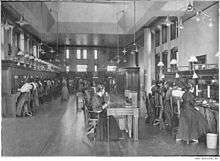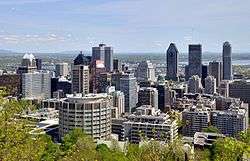Area codes 514 and 438
Area codes 514 and 438 are telephone area codes of the North American Numbering Plan (NANP) for Montreal and most of its on-island suburbs, specifically the Island of Montreal, Île Perrot, and Île Bizard, in the Canadian province of Quebec.
Area code 514 was one of the original area codes assigned by AT&T in 1947. The original numbering plan area (NPA) was split twice, in 1957 to create area code 819, and in 1998 to create area code 450. In 2006, the entire remaining 514 area was assigned a second area code, 438, in an overlay plan, making ten-digit dialing mandatory in the Montreal area.
The incumbent local exchange carrier (ILEC) in the service area is Bell Canada. The major competitive local exchange carriers (CLEC's) are Vidéotron, Telus, Rogers.
History

Montreal's local calls were originally handled manually by operators; a called party was requested by name before the first (four-digit) local numbers were assigned in July 1881. In 1898, exchange names ("Main", "Westmount", "Uptown" or "East") were added before the number. The initial rotary dial exchange, "Lancaster", was deployed April 25, 1925.[1] Subscribers dialled two letters of an exchange name and four digits (2L+4N), so "Lancaster 1234" became LA-1234 (or 52-1234).[2]
The initial area codes were created in 1947 as routing codes for operator-assisted calls. Québec and Ontario were the only provinces that received multiple area codes. Quebec was split between area codes 514 and 418. 514 was originally assigned to the entire western half of Quebec, from the Canada–US border to the Hudson Strait. This area nominally included several remote areas in the far northern portion of the province which, at the time, did not have telephone service. When the Bell System implemented direct distance dialing (DDD) for content-wide service using a seven-digit local telephone number, prefixed by a three-digit area code, Montreal and Toronto, the largest Canadian cities, were still using six digits (2L-4N) numbering plans. Between 1951 and 1958, telephone numbers were lengthened by adding one digit (3L-4N) to be compatible.[3] Numbering plan area 514 was split in 1957 to create area code 819 for most of western Quebec, from Estrie (Sherbrooke) to the Ontario border, with the then-unserved far northern portion nominally added to 418 (and later moved to 819). 514 was reduced to the region surrounding Montreal.
This configuration remained unchanged for 41 years. In 1998, the off-island suburbs (Laval, Montérégie, etc.) received area code 450, which now completely surrounds 514. This left 514 as the Island of Montreal and a few surrounding smaller islands, making it one of the six pairs of doughnut area codes in the numbering plan, and the only one in Canada.
The 1998 split was intended as a long-term solution to a shortage of available numbers in Canada's second-largest toll-free calling zone. However, within less than a decade, 514 was close to exhaustion due to the proliferation of computer, pager, and cell phone technologies, a problem exacerbated by the proliferation Canada's inefficient system of number allocation. Unlike the United States, Canada does not use number pooling as a relief measure. Every competing carrier is assigned blocks of 10,000 telephone numbers, corresponding to a single central office prefix, in every rate centre where it plans to offer service. Once a telephone number is allocated to a carrier and rate centre, it cannot be reused elsewhere, even when a rate centre has more than enough numbers to serve it. This resulted in thousands of wasted telephone numbers. Many larger cities have multiple rate centres which have never been amalgamated. Montreal is an exception; it is Canada's second-largest rate centre.
The number allocation problem was not as severe in Montreal as in other areas of Canada, since numbers tend to be used up fairly quickly. However, it was apparent that the area needed another area code. On November 4, 2006, numbering plan area 514 was overlaid with area code 438. This required ten-digit dialing for all subscribers in the Montreal area, even for local calls. By this time, overlays had become the preferred relief measure in Canada, as they affect existing subscribers the least and provide a workaround for the number allocation problem. No area codes have been split in Canada since 1999.
Although the number allocation problem has never been addressed, under current projections, Montreal will not need another area code until 2023.[4] Despite Montreal's continued growth, 514/438 is nowhere near exhaustion.
Area code 438 was considered for overlaying 450 as well, but a later decision determined that 579 would be the overlay code for that area.[5]
As of February 2017, Area code 263 is reserved for a third area code in the region.[6]
Service area
- Montreal — most of (514)/(438) except as listed below
A few western on-island suburbs (the "West Island") were never combined into the main Montreal rate centre and therefore have a reduced subset of the Montreal local calling area. In some cases, the corresponding municipality disappeared in the 2002-06 forced amalgamation, but the restricted local calling area remains. These arbitrary boundaries do not necessarily correspond in any way to the original boroughs, the "une île, une ville" municipal amalgamation or the subsequent de-fusion of areas like Westmount.
- Île-Perrot — (514) 320, 425, 446, 453, 477, 478, 536, 539, 612, 646, 681, 901, 902, (438) 257, 638, 700, 890
- Lachine — (514) 300, 307, 403, 420, 422, 469, 471, 492, 532, 538, 552, 556, 600, 631, 633, 634, 635, 636, 637, 639, 689, 780, 828, (438) 264, 600, 819, 891
- Pointe-Claire — (514) 319, 426, 427, 428, 429, 457, 459, 500, 505, 534, 541, 558, 630, 671, 674, 693, 694, 695, 697, 698, 782, 783, 900, (438) 265, 500, 538, 893
- Roxboro — (514) 309, 421, 472, 491, 533, 542, 545, 613, 615, 628, 676, 683, 684, 685, 752, 763, (438) 894
- Sainte-Geneviève — (514) 305, 308, 479, 535, 547, 551, 565, 620, 624, 626, 675, 682, 696, 700, 784, 785, (438) 818, 895
Due to Canada's number allocation system, when a CLEC reserves one prefix for each of the island's six rate centres (including Montreal), it has the effect of reserving 60,000 numbers before enrolling its first subscriber.
References
- http://www.mccord-museum.qc.ca/en/collection/artifacts/BELL-8511-1
- “POntiac-5000 – Our Disconnected Past” Archived 2014-12-15 at the Wayback Machine, The English Corner – by R. Ghandhi, page 56, The Suburban – October 21, 2009
- http://jbb.poslfit.com/Pages/514.html
- https://nationalnanpa.com/reports/2019-1_NPA%20Exhaust_Projections_Final.pdf
- http://www.newswire.ca/en/releases/archive/July2009/28/c9180.html
- https://crtc.gc.ca/eng/archive/2017/2017-38.htm. Missing or empty
|title=(help)
External links
- CNA exchange list for area +1-438
- CNA exchange list for area +1-514
- Official planning letter on NANPA's website.
- Area Code Map of Canada
| Quebec area codes: 367/418/581, 438/514, 450/579, 819/873 | ||
|---|---|---|
| North: 450/579 | ||
| West: 450/579 | 514 and 438 | East: 450/579 |
| South: 450/579 | ||
